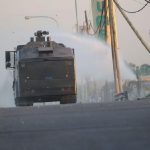
On december 8th, 2010, the Metropolitan and Federal Police attacked the 200 families who had settled in Parque Indoamericano (Buenos Aires), as if it was an enemy army: the operation ended with two deaths and many injured. Then, the local gobernment and mass media promoted xenophobia, presenting the abandoned park as “squatted” by bolivians and paraguayans linked with drug dealing: so racist groups from the neighborhoods, together with violent hooligans – patotas de barrabravas , close and often directly hired by the local government- continued the job, killing two more of the settlers.
Behind these events, hidden under the profusion of discourses, there are the city’s and Argentina’s important problems: the lack of a serious housing policy, especially in southern Buenos Aires (in one of the Villas around the park, 1600 houses had to be built since 5 years ago); the savage racism and classism of Argentina’s oligarchy and middle class, and the media’s obsession with security, now serving the cause of a massive gentrification; the criminalization of all grassroot movements close to the “piqueteros” (Frente Dario Santillan, Corriente Clasista Combativa, Frente de Organizaciones en Lucha are all very active in the area under attack).
- In brief, behind those four deaths there is “over a century of repression and evictions in the battle for the land“ (Agencia de Noticias Red Accion, 2010): from the “conquista del desierto” at the end of XIX century, through the beginnings of the Villas Miseria, the effort to wipe them up, the imposal of an economical model during the dictatorship, to the rebellion and repression in 2001.
- Photos and account of Cooperativa SUB: “Villa Soldati hoy” [broken link: photos here]
- Videos: [1][2]
- Report and interviews in Lavaca.org: “Buenos Aires es indoamerica“
- M.F.Girola (2004) “Imaginarios urbanos en zonas verdes y zonas rojas de la Región Metropolitana de Buenos Aires“, Cuadernos de Antropología Social n.20
- Maria Cristina Cravino (2011) “Structural transformations of slums in Buenos Aires“, Annual Research Committee 21 Conference